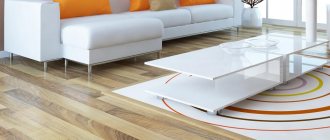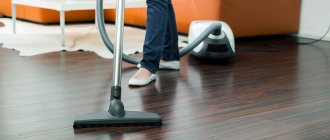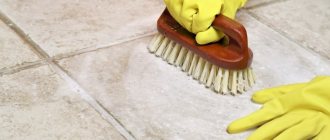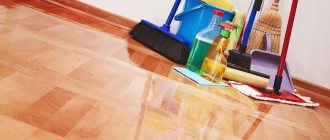Linoleum is a popular floor covering, practical and not very expensive. But during repairs, stubborn stains form on any material, even the highest quality ones. And we need to solve two problems at the same time - get rid of dirt and not spoil the appearance of the floor covering. For complete, high-quality cleaning, you can use both specialized and folk remedies. But there is a list of compounds that definitely cannot be used to clean the floor, since they can hopelessly ruin the appearance of linoleum. These are kerosene, gasoline, turpentine, ammonia, soda.
Cleaning linoleum after repair work
What products are prohibited from using when cleaning linoleum?
Linoleum is a very popular and affordable type of floor covering in any room: home, office, cottage, apartment. Linoleum is not expensive (compared to carpet, parquet, tile or carpet). To preserve it and enjoy the long service life of the coating, you should carefully and carefully care for the linoleum. At the moment, there are several methods and types of products that allow you to care for linoleum (homemade and chemical). Which one is the most effective and safe is up to you to decide.
How not to wash linoleum:
- Bleach. We are talking about a concentrated product, so to speak, in its “pure form”.
- Chemical solvents . They can be used in minimal quantities, for example, to remove a small stain locally.
- Soda and lye. They can disrupt the structure of the coating and cause it to crumble.
- Abrasives (powder). They can scratch the surface of the linoleum and damage it.
Lenoleum is a coating that can imitate parquet pattern
General recommendations
There are many recommendations, following which you can avoid all sorts of problems associated with cleaning linoleum.
If changing linoleum is not part of your plans, and minor repairs are inevitable, then the simplest action would be to cover the floor. It is not necessary to specifically buy a film to cover the floor surface; you can use old wallpaper, newspapers, boxes, or packaging film from under the wallpaper. Since all these materials are smaller in size than the surface area, you can fix them with construction tape.
But if it so happens that the remains of building materials end up on the linoleum, then you should not use objects with sharp edges for cleaning. Drops of paint and remnants of stuck wallpaper should not be wiped off with a construction knife or spatula, as there is a high probability of damaging the surface of the linoleum.
Extreme caution must be exercised if aggressive agents are used as surface cleaning auxiliaries.
To check their effect, you must first test it on a small area, or better yet, on an unnecessary piece of linoleum.
The use of all kinds of alkaline solutions and soda is strictly prohibited. Products that contain alkali in different percentages penetrate deeply into the structure of linoleum, leading to the destruction of the material. The appearance of any linoleum will be irretrievably lost, and then the entire coating will have to be changed.
When working with any means, you must use special protective gloves. They can be purchased at any hardware store, they are not expensive, and they will protect the skin of your hands from the effects of the products used.
Homemade linoleum cleaners: what can you use to clean the floor?
“Homemade” linoleum cleaning products:
- Flaxseed oil - this product will help you hide the most common problem that occurs with linoleum - scratches. Just soak a sponge in oil and lubricate the scratch area, and then rub it dry with a dry cloth. Remember that oil will help you hide only minor defects, as well as give the linoleum a pleasant shine.
- Soapy solution - unlike parquet, linoleum can be washed with soapy water. But there are several features here: the solution should not be hot and too concentrated. After the soap solution, rinse the floor with clean warm water.
- A solution based on dishwashing detergent and vodka. Pour 1 tbsp into a bucket of water. any dish soap and a glass of vodka. Carefully spread the solution using a sponge or rag (a mop with a microfiber attachment is an option). This recipe will help you remove any dirt and stains from linoleum.
- Milk and warm water. The ingredients are mixed in equal proportions. This product perfectly removes dirt from linoleum. After washing with milk, the area is wiped with vinegar (a kind of disinfection that will prevent milk bacteria from spreading and emitting a bad smell).
IMPORTANT: Remember that any “folk” floor cleaner is best used locally, but not for the entire floor. The best products for cleaning linoleum are specialized solutions.
Linoleum is an affordable and durable floor covering
How to clean an apartment after renovation from specific contaminants
After repairs, various types of specific contaminants remain. You need to choose an effective linoleum cleaner for each case.
How to clean linoleum from lime and cement
How to wash linoleum if it is stained with lime or cement dust? This issue must be resolved immediately upon completion of the repair if such a problem arises.
A dirty looking floor covering is unlikely to lift the mood of the home owners
Lime or cement always makes relin look dull and feel rough to the touch. We wash the floor like this: first use warm water with a small amount of dishwashing detergent. A tablespoon is enough for a bucket of water. Then we wash the floor with a saline solution: for 10 liters of water you need to take half a glass of salt. If the dirt has not been completely removed, you can add 100 ml of vinegar to the salt water. All that remains is to complete the cleaning by wiping the floor with clean water. If the cement is ingrained, you will need to dilute 100 g of kerosene in a bucket of water. The coating is washed with water and vinegar a second time to remove the odor.
Related article:
How to wash a mirror without streaks in different ways: with water, various folk remedies, household chemicals, a napkin with an antistatic agent, how to remove limescale and traces of stickers and markers - read the publication.
How to remove primer from linoleum
It is not so easy to remove primer from the floor, especially if you miss the moment when it is still fresh. Fresh primer can be removed with a soft cloth and simple mopping. The frozen substance is wiped off using a special remover or a solution of acetone and water in a ratio of 3:2. You can use nail polish remover and a hard sponge.
How to remove polyurethane foam from linoleum
A drop of polyurethane foam immediately turns into a bump on the coating. And this bump is not needed on the floor surface. If the foam just fell and did not have time to harden, it is removed with a spatula, collecting it from the edge to the center. For this, it’s good to have a foam remover on hand: PENOSIL Foam Cleaner or ULTIMA Professional, OPPA.
If the substance has hardened, it is cut off with a sharp cutter. There are also cleaners for hardened ones, for example, PENOSIL Premium Cured PU-Foam Remover. You can wipe off the foam with the pharmaceutical product Dimexide.
If the polyurethane foam hardens, removing it is not an easy task, but Dimexide does an excellent job
How to remove whitewash from linoleum
How to clean whitewash from linoleum? Even if the stain is old, you need to get rid of it.
Cleaning scheme: wash the floor with a solution of water, soap and salt (4 tablespoons per 10 liters of water). The water is changed to fresh with the addition of several crystals of potassium permanganate (properly dissolved). If stains from whitewashing remain, then add 2 tbsp to the water. l. kerosene, the smell of which will have to be removed with a weak vinegar solution. Finally, rub the coating with a woolen cloth.
How to remove paint stains on linoleum
We figured out how to wash linoleum, but what to do if, during the process of painting walls or doors, paint spilled on the floor or a few stains remained from it? Don't wait for the paint to dry: take a cloth and soak it in vegetable oil. Usually the stain immediately disappears without a trace. If the stain resists, then rub it off with a stiff brush.
Is the stain frozen? It’s sad, but fixable: White Spirit and other solvents are applied to a cotton pad or cloth and the paint is wiped off. The floor should be immediately rubbed with linseed oil.
Flaxseed oil is not only for health, but also for the shine of the floor!
How to remove glue stains from linoleum
It happens that glue gets on the floor. If you notice this immediately, the substance is removed immediately with soapy water.
Hardened glue is removed with White Spirit
You can remove frozen glue with gasoline. After treatment, linoleum is immediately washed with plenty of water. Traces of adhesive tape are removed with alcohol, essential oils or the same White Spirit. It is better to take proper care of the safety of the floor before starting all work by covering everything with a polyethylene sheet and securing it with tape to the baseboards. Good luck with your renovation and clean floors in your home!
Which rag is best to wash linoleum?
INTERESTING: After the first laying, you cannot wash linoleum at all, because it can become deformed. At first, dry cleaning is acceptable: with a broom, vacuum cleaner, dry cloth.
It is important to know that before washing linoleum, it should be vacuumed or swept. Small particles of debris (grains, crumbs) can scratch and damage the linoleum. Choosing the right cloth is also important, because a good cloth will not leave streaks or puddles of water and will make the linoleum clean.
What rags are suitable:
- Woolen rag. Will help linoleum restore its shine. The cloth should be moistened in warm, clean water.
- with drying oil and then rubbed with a soft silk cloth.
- Soft cloths (synthetics and cotton) are suitable for daily wet cleaning.
- For daily and “general” cleaning of linoleum, any modern soft rags : microfiber, with nanoparticles, or bamboo fiber.
What rags are best to wash linoleum?
We remove dirt from linoleum correctly
Only linoleum for industrial and commercial purposes is covered with a protective outer layer, but it is more expensive and is rarely used in residential premises. Ordinary household flooring can be easily damaged by construction mixtures, so it is useful to learn how to wash linoleum after repair and not damage the surface.
Light stains can be removed with warm soapy water. The surface is washed quickly to prevent drying out - soap damages the linoleum. Then the floor is washed with cold water. A highly textured surface can be ideally cleaned with a powerful vacuum cleaner.
How to clean linoleum after renovation if there is a lot of construction dust on it? Wet cleaning will attract even more dirt, so dry cleaning is preferable. It is convenient to use several special absorbent wipes for this. Garbage can be collected with a vacuum cleaner or swept away with a broom or soft brush.
Cleaning linoleum from dried wallpaper glue: tips, recipes
Wallpaper glue that remains on the floor after renovation can be removed in three ways:
- Soapy solution. Suitable in cases where the glue has not dried on the floor for several days and is quite “fresh”.
- Special floor cleaner. There is a large assortment of them in the store and each one effectively fights pollution.
- White spirit will help remove traces of old and dried glue from the floor.
Linoleum cleaning products
Cautions and Recommendations
To avoid dirt on the surface when carrying out repairs, it must be covered with old newspapers, oilcloth or plastic film. The joints can be glued together with mounting foam or masking tape. When joining the material, it is better not to use ordinary transparent tape. It leaves traces of glue on which dirt and dust accumulate. They are difficult to remove from the surface.
In order to protect linoleum in everyday use, you can create an additional layer of mastic or polish on it. This layer is updated every six months. It protects the linoleum surface from external influences. Prevents the formation of heavy dirt
Cleaning linoleum flooring after repairs is a very difficult, sometimes even protracted process. Therefore, before undertaking repairs, it is necessary to take care of the preservation of the appearance of the floor covering, using available means - newspapers, films, etc. Even if the floor is dirty, a housewife has many variations in her arsenal on how to clean linoleum after repair.
Cleaning linoleum from marker: methods and tips
Adviсe:
- The water-based marker can be wiped off with water and soapy water.
- Alcohol-based markers can be removed using any alcohol solution or vodka, in which a cotton sponge should be soaked.
- You can wipe off a marker on any base using toothpaste; to do this, apply it to the stain, leave it for a short time, and then wipe it off with a wet napkin. After the procedure, the linoleum is rubbed with polish or linseed oil (then rubbed dry).
How to care for linoleum
To make linoleum look beautiful for as long as possible, you should adhere to some rules:
- any stains (paint, primer) must be removed from it immediately, before the pollutant is absorbed;
- When washing, do not use abrasive cleaners, solvents, bleach and aggressive disinfectants;
- the use of soda and ammonia is strictly prohibited;
- A mixture of equal parts water and milk will give linoleum freshness;
- to maintain a beautiful appearance, once a month it is advisable to wipe it with linseed oil or a special mastic made from four parts of turpentine and one part of rosin;
- You can wash linoleum only with warm water, but not hot.
How and with what to clean linoleum from grease and greasy stains in the kitchen?
In order for your linoleum kitchen floor to shine and be “like new,” it should be looked after as often as possible and preferably washed daily. If this is a problem for you, just take care of those places that are most susceptible to contamination (near the stove and dining table). To care for kitchen linoleum, you should choose special detergents or dissolve dishwashing detergent in water (it dissolves grease perfectly).
You can wipe off any stain from linoleum
How to wash?
After repairs, linoleum can be restored to its original appearance using a wide variety of means. The use of a particular substance, as well as methods of application to the surface, depends on the type of stains left. Thanks to the painstaking work of specialists, based on the interaction of chemical components, the surface of linoleum can be cleaned and washed quickly and without damaging the structure of the coating.
Lime and cement
The most common types of contaminants include lime and cement. They can settle even if the floor was previously covered with polyethylene. A small amount is enough to make the linoleum surface dull and untidy; even repeated washing of the floor with usual cleaning products will not help.
But there is a way out, thanks to very simple means. Table salt and soap will help to wash linoleum . You need to prepare a solution from these two components. First you need to grate the soap, just take 3-4 tablespoons in a bucket of water and drop the finished shavings into the bucket. Add 3-4 tablespoons of regular salt there and mix everything thoroughly. The water temperature should be within 30-40? C. You cannot use hotter water, as the pattern on the surface may fade.
How to remove plaster mixture?
Before removing putty or plaster mortar from the surface, you need to pay attention to its appearance. Plaster is a wear-resistant material, so many types can only be washed with household chemicals or solvents. Fresh stains from any type of mixture can be easily removed with warm water. But after the material hardens, you will have to use more serious means.
Plaster
The gypsum-based mixture hardens very quickly, and then it is difficult to wipe it off:
- To remove the gypsum mixture, you need to prepare a vinegar solution. To do this, you will need to mix 50 ml of vinegar in 2 liters of warm water. It is advisable to use high-quality vinegar to achieve maximum effect.
Methods for cleaning walls from putty
In practice, to clean the wall from excess putty, you can use the two most relevant methods, namely:
- Mechanical cleaning with a spatula or knife.
- Using a chemical remover for processing.
Each individual case has its own technological process. In this case, everything should be done carefully so as not to damage the structure.
Important. It should be understood that depending on the wall coating, the appropriate cleaning option is selected.
Chemical remover
In practice, this option is used only for an even structure, since the use of a spatula or scraping knife is unacceptable here. This composition is poured onto the surface, after which the product is rubbed with a cloth with large pile.
How to remove plaster, traces of whitewash
It is better to wipe off dried plaster stains as dry as possible. If there are tiles on the floor, just scrape it off with something, but try not to scratch it. For softer surfaces—linoleum—soak with acidified water (add vinegar) and scrub off little by little. If it is too difficult, any product with active acids will help to clean the floor. Among the most affordable are Toilet Duckling and similar products for the toilet or bathroom. But first read the composition - hydrochloric or any other acid should be indicated there. Just don’t try it on linoleum, parquet or laminate. Most likely, the coating will be damaged. If there is scrap material, test the product on it. After testing, is there any damage or discoloration? Try cleaning the plaster from the floor with this product.
How to wash linoleum after repair - with simple means: water + vinegar + dishwashing detergent
To clean the floor from putty or plaster, first try diluting a capful of the found acidic product in a small amount of water (a liter or one and a half). Apply the solution to the stain and wait a few minutes. Let's try to scrub it off. It helped - great. No, we're trying to increase concentration. Particularly persistent ones can be treated with an undiluted product. But if it doesn’t help, most likely you need to look for another remedy.
You can try softening plaster or putty stains with kerosene. Drop a couple of drops and wait, then try to wipe it off. But remember that it is better not to apply kerosene to laminate and linoleum.
When working with acids or kerosene, try to breathe “to the side.” Literally. The acid and kerosene evaporate and the vapor enters the lungs and can cause severe coughing. If you breathe long enough, it can even cause poisoning. In general, open the windows, ventilate and be careful. Whitewash, putty and other repair compounds are removed in the same way.
What is used to clean old linoleum?
You should first decide where the stains come from and how complex they are. If the linoleum is heavily soiled or the stains are yellowed, then a soap solution with the addition of vodka or alcohol (1 tsp of soap per 200g of vodka) can effectively remove them.
The use of this product is necessary if the type of linoleum covering is corrugated, and also if there is super glue left on it.
Some time ago, stains on linoleum were removed using a mixture of milk and water, taken in a one-to-one ratio. But after washing the stains with this product, mastic was applied to the linoleum. Following this, disinfection was carried out using vinegar essence or vodka.
All of these products help to wash old linoleum, making it clean and attractive.











